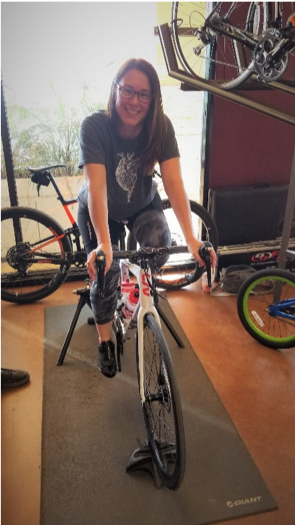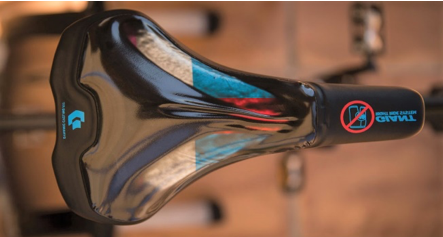Ouch, my butt hurts, my hands go numb, and my feet get hot. I hear these things a lot! When someone explains to me how much they dislike riding because of the pain and discomfort they are having, my next question is “Have you had a bicycle fitting?” The answer to this can go a few separate ways;
- “When I bought the bike, one of the sales guys put me on a trainer and made sure I was good,” or
- “I bought this bike used, but he said it should fit me fine.”
Let’s go over what a bike fitting is, and what a bike fitting is not. A bike fitting is a full body comprehensive session that includes:
- range of motion testing of the rider,
- flexibility testing, checking for limb discrepancies,
- stabilization of the rider on the bike, and
- sport or activity positioning based on the measurements taken.
 The fitting process should start with a personal interview about you and what your goals are as a rider, along with any issues that you have on or off the bike. This interview will be followed by a full body assessment that takes real number measurements of your body’s capabilities and structure. Lastly, it’s you on the bicycle with the fitter manipulating the bicycle to fit your body in its most efficient and comfortable position (based on the numbers gathered from the assessment). What a fitting is not is someone having you get on a bike and saying “you look like you’re in an acceptable position” or maybe using a plumb bob to get close (that is an initial “sizing” of a person to a bike).
The fitting process should start with a personal interview about you and what your goals are as a rider, along with any issues that you have on or off the bike. This interview will be followed by a full body assessment that takes real number measurements of your body’s capabilities and structure. Lastly, it’s you on the bicycle with the fitter manipulating the bicycle to fit your body in its most efficient and comfortable position (based on the numbers gathered from the assessment). What a fitting is not is someone having you get on a bike and saying “you look like you’re in an acceptable position” or maybe using a plumb bob to get close (that is an initial “sizing” of a person to a bike).
It is extremely hard to fit yourself. I fit people for a living, and I struggle with my own bike fit at times. It requires more than a “fit yourself in two minutes” video to get it remotely close.
How do we become comfortable and efficient at the same time? By filling the void between how your body can naturally support itself and where your current bicycle setup is, using the numbers taken in the full-body assessment. This may require:
- raising or lowering the handlebars,
- rotating the handlebars and the shifters independent of each other,
- bringing the bars closer or moving them farther away,
- raising or lowering your saddle,
- adjusting the tilt, fore and aft on your saddle,
- measuring you for the proper saddle width,
- adjusting cleat positioning,
- supporting your arch and your forefoot where needed,
- creating a supportive platform on both the X and Y axis.
This is part of what happens in a proper fitting, and this is the road map for both comfort and efficiency. Every single person is different, and fittings vary widely. Don’t assume something that works for your riding buddy will work for you: most often it doesn’t.
Here are some tips for riding efficiently and what causes issues some of the most common issues:
Don’t pedal in circles! There is a long-standing myth that pedaling in circles is the most efficient way to pedal. I strongly disagree with this. When you push on one pedal and try to pull up on the other side you are shorting the amount of power (Watts) that the pushing leg can put out. The most efficient way to pedal is to push down on one pedal and let the other one come back up. If you apply all your energy to the pushing leg and “turn off” your pulling leg, that leg will naturally come up. Your body was not designed to push and pull at the same time: don’t weaken the leg that’s putting in 90% of the power to help the leg that only inputs 10% of the total power. I have had many conversations with fitting experts on this subject. The most recent has been with the head fitter of pro cycling team Lotto-Jumbo, whose data in their labs backs this up. When your leg reaches extension, turn it off and focus on the push. Use your quads, they are big for a reason!
My hands go numb and tingle! Why are they going numb is the question? The answer is typically the rider compressing the Ulnar Nerve in their palm. This compression happens from being in a poor position relating to angle of your hands in conjunction with the shifters and handlebar positioning. This can be remedied by being placed in the proper supportive position while allowing your ulnar nerve to be free of compression. Gloves can also help to allow more room between your palm and the shifter, but gloves should be the supplement, not the “Fix”.
Hot spots on your feet are caused by an irritation to the sesamoid bones in your foot. When irritated, these can cause a big irritation and make your ride very uncomfortable. Cleat positioning on your shoes are to blame here. Typically moving your cleats back a few millimeters will help to remedy this issue. The center of your cleat should bisect your first and fifth metatarsal bones. This measurement is easy to take by a professional while examining you on the bicycle. 
Butt, butt, butt, I am in pain after a few miles. We all know this feeling, whether it’s on a 10-mile ride or a double century, it’s happened to most all of us at some point. What causes a sore bottom? There are many factors and many various places on your lower end that can hurt. The most common is saddle positioning and shape. Your saddle should be in a position where it places you, the rider, on its widest part in a neutral fitting that stabilizes you. This positioning should allow for the center of your body to be centered over the bottom bracket of your bike, creating a solid foundation.
Time Waits for No One. Always keep in mind that bodies and cycling positions change over time and with different disciplines. Sometimes a saddle that worked for you when you were 10 pounds heavier or lighter no longer works. Change your cycling shoes every couple of years and keep your bar tape, chamois, and gloves in excellent condition. Use your local bike shop as a resource for a professional fitting: most of us have had some level of certified training.
These are just a few of the most common issues that I hear, so I wanted to address these first. If you are having issues on the bike or if you want to be in the most efficient position for you, get a professional fitting. Keep in mind that lasers are not always the best. Having the experience to use tools properly goes a long way to getting you dialed in. A good bicycle fitting will allow you to ride the type of rides that you want to without any discomfort or pain while making every single pedal stroke count as an efficient extension of your body.
-Devin Bovee
Devin@stevensbicycles.com
559.797.0148
